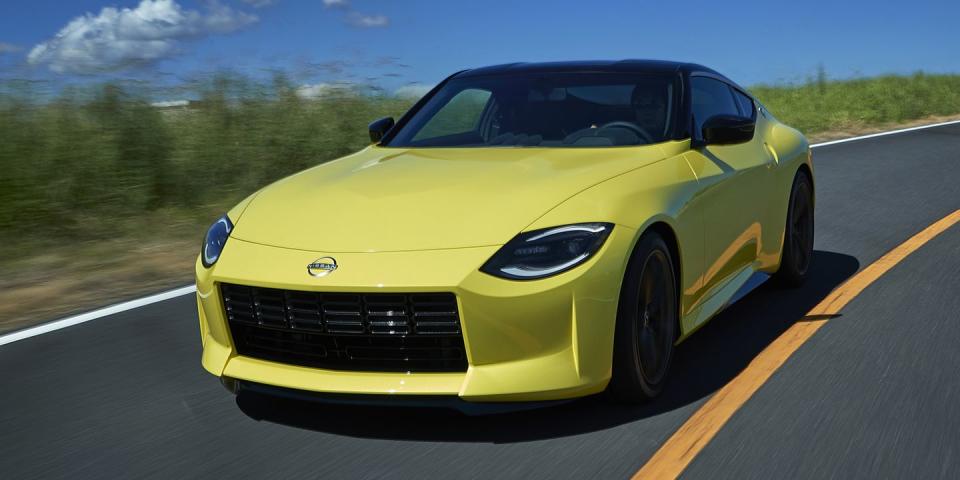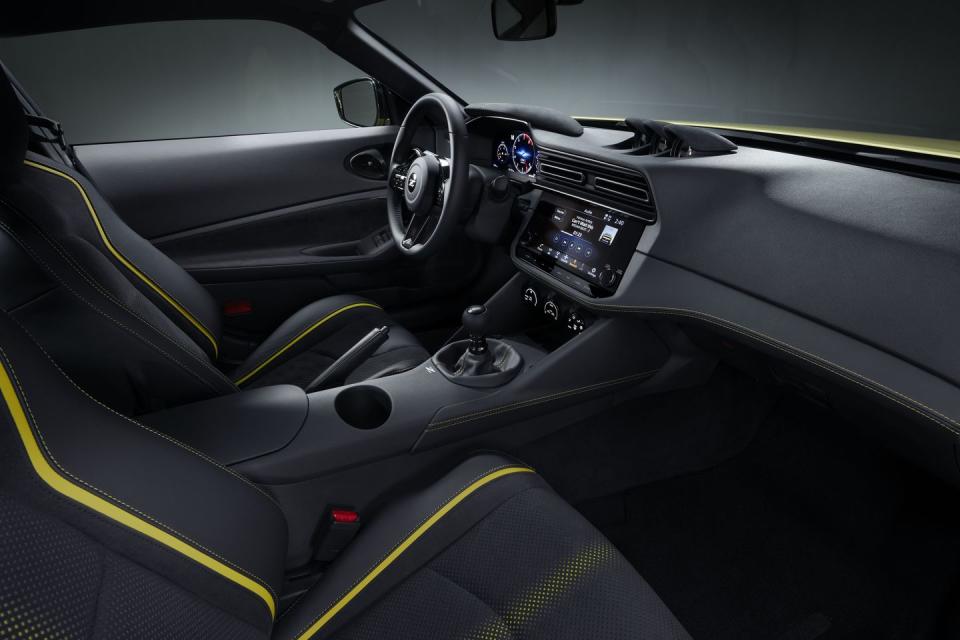Everything We We Know About the 2023 Nissan Z

The Nissan Z is one of the most important sports car families of all time. Its members include the iconic 240Z, the game-changing Z32 300ZX, and the tuner hit 350Z. But today's 370Z is starting to wither on the vine. Quick and exciting as it may be, the decade-old Z is dated and spartan inside. But a replacement is coming. Here's what we know so far.
Update: The production-ready 2023 Nissan Z made its official debut on August 17, 2021. A full breakdown of the new sports car can be found at the link provided here.
It Will Look a Lot Like This
On September 15, Nissan launched the Z Proto, a near-production-ready prototype of its new Z sports car. With a retro-inspired design, the car is pretty much what the road-ready Z will looks like once it hits dealerships next year. The front end has a massive, boxed grille taken from the original 240Z, while the rear light cluster shares much of its styling with the Nineties 300ZX. There are other throwback styling touches as well, including the fastback roofline and teardrop-shaped headlights. For a more in-depth analysis of the car's looks, head on over to our dedicated gallery.
In late March, photos of what looks to be the production version of the Z hit the web, giving us our best look yet at the differences we should expect between the prototype and the full-on road-ready model. There's a redesigned grille, a duckbill spoiler, bumper reflectors, and parking sensors, among other things.
Its Twin-Turbo V-6 Should Make Around 400 HP
The new Z will be powered by a version of Infiniti's 3.0-liter twin-turbo V-6, sending power to the rear wheels. Nissan hasn't release specs or performance numbers yet, saying only that it'll be more powerful than the current 370Z's 332-horsepower 3.7-liter naturally aspirated V-6.
We suspect the car will use the 400-horsepower version currently found in the Infiniti Q50 and Q60 Red Sport 400. It won't be the first time we've seen this variant in a Z—Nissan built a current-gen 370Z with the powerplant called the Project Clubsport 23 for SEMA in 2018. A rumor from late March claims the 400-horsepower engine will be standard at launch.
It Will Have a Manual Transmission

The Z Proto shown above is equipped with a real, actual six-speed manual transmission, which Nissan says will be standard on the production car. This gives the car an edge over its main competitor, the Toyota Supra, which is currently only offered with an eight-speed automatic.
Of course, a fast-shifting automatic will be available as an option for those who'd rather let the car do the shifting.
It Will Use a Heavily Modified Version of the 370Z's Platform
On the day of the Z Proto's launch, Nissan product specialist Hiroshi Tamura confirmed in an interview the new Nissan Z will use a heavily modified version of the current Z architecture, rather than an entirely new platform. This contradicts previous reports claiming the Z might instead share its underpinnings with the Infiniti Q60.
In a world where sports cars are an ever-shrinking portion of the market, it's not exactly easy to justify the development of an all-new architecture. So this move makes sense. Hopefully it won't have a negative impact on how the car drives.
The Official Name Is Still Up in the Air
One thing we don't know is what it'll be called. Normally we assume that a new generation of a car will retain its current name, but Nissan's Z cars usually change names every generation. Historically they've been based on displacement; the 300ZX had a 3.0-liter engine, while the 350Z had a 3.5-liter engine and so on.
Problem is, if the 3.0-liter turbo engine does end up powering the next Z, we find it hard to believe that Nissan would bring back the 300Z name. Generally, numbers in the automotive world perpetually go up, a quirk of marketing where you never want to sell something that seems "lower" than last year's model. That's why we're expecting it to be called the 400Z, as Autocar reported. The term "Z Proto," as far as we can tell, has been reserved only for the prototype we've been shown above.
A March report from a forum user who claims to be in the know says the new car will simply be called the "Nissan Z" in the United States, while carrying the Fairlady Z nameplate in Japan.
It Might Be Cheaper Than We Expected
That same report claims the 2022 Nissan Z will start at just $34,995—much cheaper than we originally thought, especially if that 400-horsepower engine comes standard. For some context, the Z's main competitor, the Toyota Supra, starts at $42,990. And that's for the base four-cylinder version.
A Nismo Model Is Reportedly In The Works
According to the Japanese publication Best Car, the 2022 Nissan Z will be joined by a more hardcore Nismo variant down the line. The model will reportedly be more powerful than the standard car, and will feature upgraded hardware such as stiffer suspension, a stronger body, and unique 20-inch wheels. The details of such a project remain scarce, though Best Car has reported that the new Nismo model will make its official debut at the 2022 Tokyo Auto Salon. Furthermore, the publication notes that Nismo is actively developing a Nissan Z GT4 car, which could replace the long-serving GT-R in Japan's Super GT race series. The brand's rival in the Toyota Supra currently races in that series against the Nissan GT-R, Honda NSX, and Lexus RC F models.
It Arrives August 17
We've had to wait quite some time now to meet Nissan's newest sports car. The automaker has recently confirmed however that the new Z car is slated to be unveiled on August 17 in New York City. A livestream accompanying the event will be broadcast on the automaker's YouTube channel. Following the reveal ahead of the New York International Auto Show, expect more details related to the powertrain and pricing to become public.
It's Not Coming to Europe
Nissan confirmed in a statement on September 16 it would not be bringing the new Z sports car to Europe, citing ever-tightening emissions regulations as the reason behind the decision.
You Might Also Like

 Yahoo Autos
Yahoo Autos 